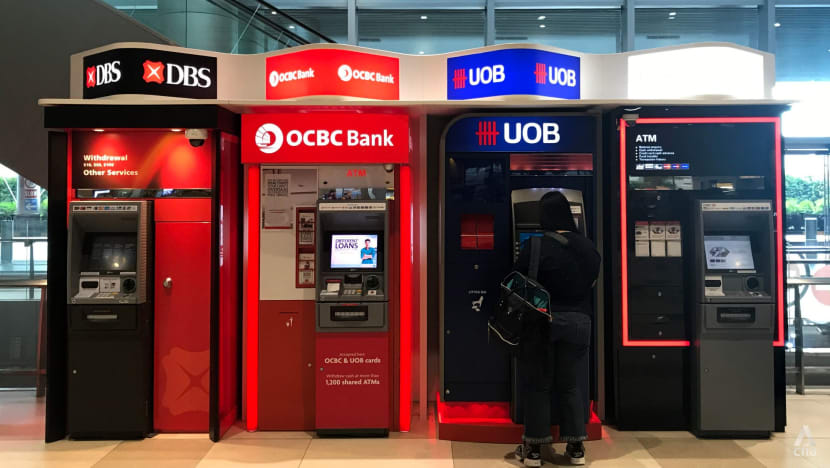Singapore bank stocks rebound after nearly S$49 billion selloff on Trump tariff fears
Even with the surprise reversal by US President Donald Trump overnight, one analyst remains cautious in his outlook for the Singapore banks, noting that "the damage has been done".

File photo of a row of ATMs in Singapore. (Photo: CNA/Jeremy Long)

This audio is generated by an AI tool.
SINGAPORE: Shares of Singapore’s three local banks recovered from multi-month lows on Thursday (Apr 10), in line with a broader relief rally in financial markets across the region after United States President Donald Trump announced a surprise 90-day pause in tariffs for most countries.
Breaking an eight-day losing streak, DBS rose 6.8 per cent to S$39.67. OCBC jumped 7 per cent to S$15.43, while UOB gained 7.2 per cent to finish the trading session at S$33.21.
Before this, the banking heavyweights have chalked up double-digit declines since Mr Trump announced sweeping tariffs on dozens of countries a week ago, sparking fears of a global trade war and recession. Based on the closing prices on Wednesday, the three local lenders collectively shed about S$48.8 billion in market value since Apr 2.
Analysts, who have downgraded their outlook for the local banking trio and cut target prices in recent days, are calling for continued caution amid heightened uncertainty.
“These Trump decision risks of on-again, off-again tariffs (which) will create paralysis in corporate capital expenditure and supply chain plans, driving demand lower,” Maybank analyst Thilan Wickramasinghe told CNA.
“The damage has been done. This will impact operating conditions for the banks by lower credit demand and fees, while also raising asset quality risks.”
"DOWNSIDE EARNINGS RISKS"
While banks may not be directly exposed to the tariffs, they will feel the impact through slower economic growth, trade and business activities, analysts said.
When growth slows, companies are likely to turn cautious about spending and taking loans. The same goes for the average consumer. Borrowers could also fall behind on payments – all of which is not good news for banks.
The tariffs and the potential chilling effect on global trade and growth are especially hurtful for Asia’s manufacturing and export-oriented economies. The region also bears the brunt of the higher US tariffs, with rates ranging from 18 per cent to 49 per cent.
“The slowdown in intra-regional trade triggered by reciprocal tariffs will reverberate across supply chains in the region,” said UOB Kay Hian, adding that the manufacturing sector may be in for “turmoil and job losses”.
Given their exposure to the region, the Singapore banks will feel the heat in terms of lower loan growth and higher credit costs due to non-performing loans, the brokerage added.
Also expecting gloomier growth prospects for Singapore and the region, Macquarie Equity Research’s analyst Jayden Vantarakis said UOB appears to be most at risk given the bank’s higher reliance on trade finance.
Expectations for more aggressive rate cuts by the US Federal Reserve are also bad news for the banking sector, whose net interest margins and overall profitability have been boosted by high interest rates in recent years, analysts said.
Furthermore, wealth management, a key driver of non-interest income for all three banks of late, may also be hit if heightened market uncertainties keep investors on the sidelines.
“We think trading and insurance income could be negatively impacted under severe market volatility. Fees, such as wealth management (and) credit cards could also see downgrades amidst higher unemployment risks and risk-off attitudes,” said Mr Wickramasinghe.
Echoing that, Mr Vantarakis expects banks to see “stalling growth” of 0 per cent to 5 per cent for their wealth franchises amid higher market risks.
Collectively, slower loan growth, declining net interest margins and more muted wealth management fees point to “downside earnings risks” ahead, said DBS Group Research.
DOWNGRADES, TARGET PRICE CUTS
Amid the gloomy outlook, analysts have downgraded their outlook for the local banking trio and cut target prices in recent days.
Maybank’s Mr Wickramasinghe on Apr 9 reduced his outlook for the sector to “neutral”. He also downgraded DBS and UOB to “hold”, while maintaining OCBC at “hold”.
The analyst told CNA he is “unlikely” to change these calls even with the latest developments.
Earlier in the week, UOB Kay Hian downgraded the Singapore banking sector to “underweight”. It also re-rated the two banks under its coverage – DBS was downgraded to “sell” with a cut in target price from S$49.80 to S$40, while OCBC was downgraded to “hold” and its target price slashed from S$21.10 to S$16.85.
Citing concerns over the “potential sequential impact from an escalating trade war environment”, DBS analysts on Tuesday downgraded UOB from “buy” to “hold” and maintained a “hold” rating on OCBC.
Target prices were also revised lower, with UOB’s slashed from S$38.50 to S$32.70 and OCBC’s lowered from S$17.60 to S$14.40.
That said, some support for the battered stocks could come in the form of decent dividend yields and share buyback programmes announced by the banks previously, said OCBC Investment Research’s Singapore strategist Carmen Lee.
Some banks have begun capitalising on recent market pullbacks to carry out share buybacks, based on recent bourse filings. For instance, DBS spent S$119.17 million to buy back some three million shares from Apr 4 to Apr 9.
There are also analysts who see the latest pullback as a possible buying opportunity. Tiger Brokers’ market strategist James Ooi, for one, said the valuations of the local banking stocks are now “starting to look more attractive to bargain hunters”.

















